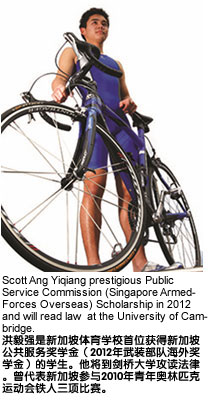 Human capital is the only resource in Singapore. If the streaming system was necessary for the industrial-based economy in the 20th century in order to nurture people in the most effective and efficient ways possible, then the knowledge-based economy in the 21st century will require the grooming of every single student in order to achieve different peaks of excellence.
Human capital is the only resource in Singapore. If the streaming system was necessary for the industrial-based economy in the 20th century in order to nurture people in the most effective and efficient ways possible, then the knowledge-based economy in the 21st century will require the grooming of every single student in order to achieve different peaks of excellence.
The Ministry of Education (MOE) has freed the students from the ranking system and has provided different kinds of learning environments for students to discover their passions. They may not be performing well academically, but those who excel in other activities like running, singing or painting can still be proud of their talent and contribute to the country.
Deputy Prime Minister Tharman Shanmugaratnam, who was the former Minister for Education, said, "No matter what kind of children we encounter, we have to discover their talent and potential which they have yet to discover for themselves."
The idea of "specialised independent schools" was first mooted in 2002. At that time, Mr Tharman led the Junior College/ Upper Secondary Review Committee in evaluating Singapore's education system during those crucial years.
"No one knows what will happen to Singapore in 15 to 20 years' time. And because of this our schools should not be limited to one model, and various attempts should be made to nurture talent in different fields," he said. "Singapore's society requires people with different abilities to contribute. Educators have to remember that our society determines the fields of specialisation of our graduates. Through providing a variety of choices, there are more opportunities catering to different talent.
The MOE wants to ensure that everyone is able to receive a holistic education and excel in their own field." He stated that in terms of quantity, Singapore has "enough" graduates. Now is the time we move in the direction of nurturing "quality" graduates.
During his term from 2003 to 2008 as the Minister for Education, Mr Tharman worked on two things: broadening the definition of "talent" and not jumping to conclusions about a child's ability and limiting his or her potential prematurely.
Therefore, an education model that is more flexible, more extensive and provides more variety was implemented.
The MOE has set different yardsticks through schemes such as Direct School Admission and Niche Programme Schools in order to do the best in discovering talent. These measures will help mainstream schools identify students of different talent and enable them to do their best in nurturing these students.
The current Minister for Education Heng Swee Keat announced that $55 million will be pumped into schools within the next five years to help them become schools that are able to start their own niche programmes in order to groom talented students.
Students who possess ability and show a strong interest in sport, mathematics, arts or technology can now study at the Singapore Sports School, NUS High School, the School of the Arts or the School of Science and Technology respectively. These four specialised independent schools were founded in 2004, 2006, 2008 and 2010 respectively. They aim to nurture talent in the sports, mathematical sciences, and the arts and technology fields. Hence their curriculum differs from the all-round model of mainstream schools and are more specialised than other schools with niche or elective programmes.
At the same time, MOE also takes care of the students from normal technical streams and Institutes of Technical Education (ITEs), students who have failed national examinations and handicapped students. These are the weaker students academically, those who were labelled "disobedient", "useless" or "substandard". Measures and policies that would help them on their path to success were implemented. These included advancing students in the Normal streams straight to higher level ITE courses, encouraging secondary schools to collaborate and conduct lessons with ITEs and polytechnics, setting up vocational schools like Northlight School and Assumption Pathway School to cater to students who failed the Primary School Leaving Examination, establishing Crest Secondary School and another specialised school for students from the Normal (Technical) streams to start in 2013 and 2014, abolishing labels such as "top schools" and "neighbourhood schools", and increasing education subsidies for handicapped students.
In this inaugural issue, EduNation interviewed the principals of two specialised independent schools - Singapore Sports Schools and School of Science and Technology, Singapore - the first and the latest, to find out about the different school models they have adopted. The other two schools will be featured in future issues of the magazine. Translated by: Chu Luo Jun
|